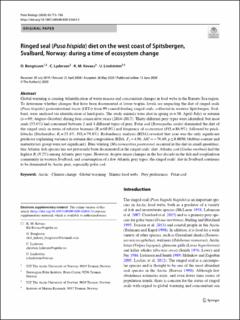| dc.description.abstract | Global warming is causing Atlantification of water masses and concomitant changes in food webs in the Barents Sea region. To determine whether changes that have been documented at lower trophic levels are impacting the diet of ringed seals (Pusa hispida) gastrointestinal tracts (GITs) from 99 coastal-feeding ringed seals, collected in western Spitsbergen, Svalbard, were analysed via identification of hard-parts. The study animals were shot in spring (n = 30; April–July) or autumn (n = 69; August–October) during four consecutive years (2014–2017). Thirty different prey types were identified, but most seals (55.6%) had consumed between 2 and 4 different types of prey. Polar cod (Boreogadus saida) dominated the diet of the ringed seals in terms of relative biomass (Bi = 60.0%) and frequency of occurrence (FOi = 86.9%), followed by pricklebacks (Stichaeidae; Bi = 23.4%; FOi = 79.8%). Redundancy analysis (RDA) revealed that year was the only significant predictor explaining variance in autumn diet composition (RDA, F3 = 4.96, AIC = − 76.49, p ≤ 0.0050; blubber content and maturity/sex group were not significant). Blue whiting (Micromesistius poutassou) occurred in the diet in small quantities; this Atlantic fish species has not previously been documented in the ringed seals’ diet. Atlantic cod (Gadus morhua) had the highest Bi (9.2%) among Atlantic prey types. However, despite major changes in the last decade in the fish and zooplankton community in western Svalbard, and consumption of a few Atlantic prey types, the ringed seals’ diet in Svalbard continues to be dominated by Arctic prey, especially polar cod. | en_US |
